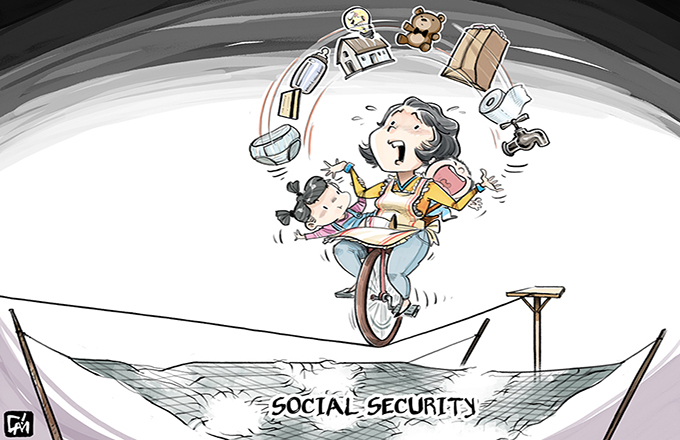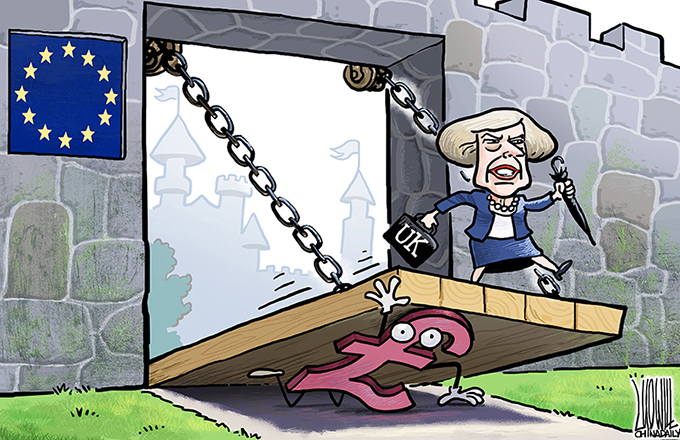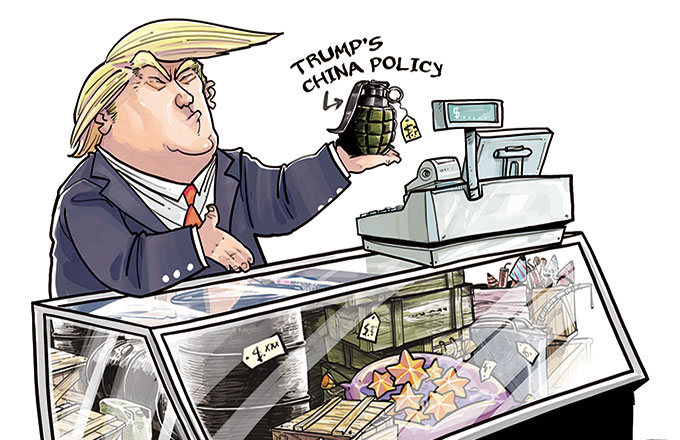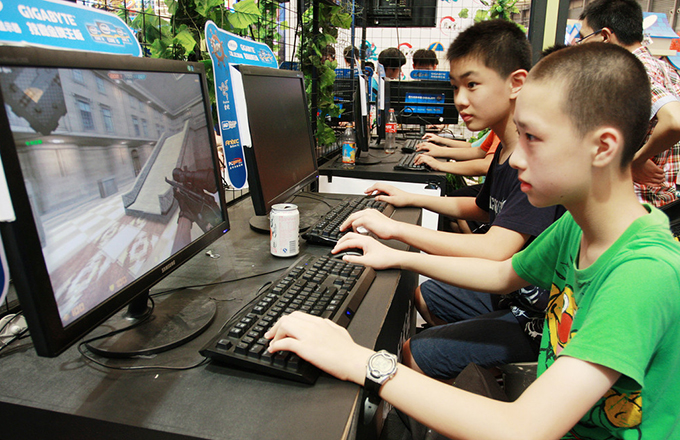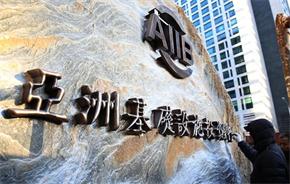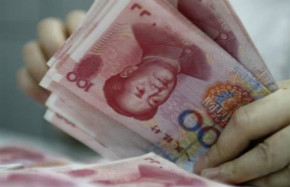Towards a stable global order
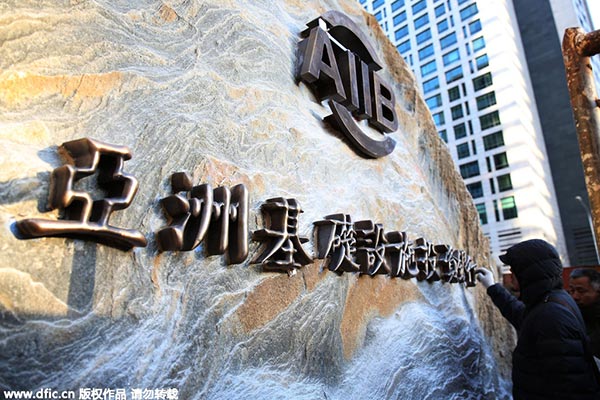 |
|
A Chinese worker installs signs on a giant rock in front of the headquarters building of the Asian Infrastructure Investment Bank (AIIB) in Beijing, January 12, 2016.[Photo/IC] |
At the onset of 2017, the world is exposed to far graver threats to its peace, stability and security than was the case in the preceding year. With transformative changes sweeping through the United States, Europe and greater Middle East, the role of the global institutions responsible for conflict management and resolution has increased manifold.
However, a more strident view on the mushroom growth and complexity of conflicts around the world has questioned the effectiveness and relevance of the international governance architecture, stating that a manifest lack of commitment to the ideals and principles of the UN Charter explains why the world is adrift chased doggedly by chaos and turbulence.
There are serious concerns on the uncertain direction the world has taken having the potential to deepen crises in different parts of the world. The interconnected nature of these challenges becomes all the more perilous when we observe that the values and notions that have founded the globalized order are under severe attack and running the risk of unraveling in the absence of a counter-narrative.
Amid concerns and apprehensions about the future of international order, President Xi Jinping has come to represent the aspirations of the world community. His call for a participatory and broad-based governance model to regulate the world affairs has found ready listeners.
As a statesman, President Xi Jinping has had his finger on the pulse of the people when he says that reform of the existing global governance system and mechanism is necessary in view of the evolution the world landscape and major transnational challenges are undergoing. His advocacy of a shared approach on the part of the world community is premised on employing innovation to revamp the existing system in an attempt to build more 'equitable, just and effective architecture of global governance', one which meets the aspirations of the people.
Two initiatives of President Xi need to be talked about here that show that China is taking practical steps to set up a model of development that benefits not just her but also builds win-win partnerships aimed at distributing the fruits of prosperity.
The establishment of the Asian Infrastructure Investment Bank (AIIB) represents China's response to the growing needs of the Asian communities for infrastructure development. This initiative is in line with China's declared aim of making greater contribution to international development endeavours, for the Chinese are convinced that much of their progress owes itself to international cooperation. AIIB will play the leadership role in the Asian continent in terms of provision of funds for infrastructure development. This role is all the more critical when seen in the context of likely funding deficit to the tune of $ 800 billion during the decade of 2010-2020 as per projection of the World Bank and Asian Development Bank.
The second initiative of President Xi Jinping is his 'Belt and Road' vision that has the potential to redefine global geopolitics by making 'shared fruits of economy and trade' the pivot of the whole dynamic concept. This initiative that proposes six corridors including the China-Pakistan Economic Corridor will eventually connect 65 plus countries through air, road, and sea routes thereby resulting in increased trade flows to the tune of $2.5 trillion according to one estimate.
The Belt and Road initiative is in line with the Chinese President's vision of 'building a community of shared interests, destiny and responsibility.' It is a part of China's grand strategy of deepening reform and opening-up. The ideas of win-win partnership that President Xi has espoused at every level whether it is UN General Assembly's 70th Session in New York, G20 Hangzhou Summit in China, or 8th BRICS Summit in India, are defined by peace, inclusiveness and prosperity.
The China-Pakistan Economic Corridor, which is a flagship project of the Belt and Road initiative, is undergoing robust implementation at the moment. The projects of worth $ 30 billion are being implemented. Eight industrial zones to bet set up in all the provinces of Pakistan will create investment and employment opportunities. With a major chunk of the CPEC investment i.e. $34 billion earmarked for energy sector projects, Pakistan's GDP will be strengthened by 2pc straightaway on their completion.
The 13th of November 2016 will do down in history as an epoch-making day when the Prime Minister of Pakistan, flanked by top civil and military leadership of the country, inaugurated the Pilot Trade Project at a prestigious ceremony at Gwadar city. The operationalization of the Gwadar port, which is the centerpiece of the CPEC, is the best news to come in recent months. The start of the trade activity represents the realization of a cherished dream and opening of a new era of peace and development for Pakistan, South and Central Asia, and Gulf regions.
The fact that the cargo containers used the overland western route during their 3000 km long movement from Kashgar to Gwadar sends multiple messages. It proves that Pakistan is a peaceful country and the CPEC route has been fully secured, thanks to elaborate security arrangements made by the government of Pakistan. The way people showed their warmth and excitement as the caravans passed through different regions shows the popular ownership of the CPEC project.
I would take the opportunity to thank the Chinese leadership particularly President Xi Jinping and Premier Li Keqiang for their highly dynamic and proactive role in the success of the whole endeavour. The opening of Gwadar port for international trade is the result of unity of thought and close coordination between our two governments.
The successful implementation of the Belt and Road initiative would help deepen regional economic integration, boost cross-border trade and financial flows between Eurasian countries and the outside world, and further entrench patterns of trade, investment, and infrastructure. The formal start of trade activity at the Gwadar port represents a landmark event in this regard.
In a world driven by various conflicts and hardcore rivalries, China is a voice of sanity that stands for collaborative efforts to negotiate the current set of challenges. The rise of China as the second largest economy and paramount military power is a lesson in how strong leadership commitment and clarity of purpose backed by amazing energy of the leadership can work wonders in a short span of a few decades.
The Chinese model of development that focuses on continuous process of internal reform, consolidation of gains, rule of law and peaceful coexistence with neighbours is holistic, containing important lessons for its friends. China has successfully bridged the North-South gap by championing the causes of the developing world at every forum.
In Pakistan, we continue to be inspired by spectacular accomplishments China has made under the leadership of President Xi Jinping and Premier Li Keqiang. The way Beijing has lifted people out of acute poverty by providing them with reasonable standard of living is a practical manifestation of the China Dream, an idea that is changing lives for the better.
As old global order faces threats of extinction, it is satisfying that the new world order with Chinese characteristics of peace and development is there to augment or better still replace it.
The writer is Chief Minister of Punjab Province (Pakistan)
The opinions expressed here are those of the writer and don't represent views of China Daily website.



